Methane Production Characteristics of an Anaerobic Co-Digestion of Pig Manure and Fermented Liquid Feed
Abstract
1. Introduction
2. Materials and Methods
2.1. Substrates and Inoculum
2.2. Reactor Operation
2.3. Analytical Methods
3. Results and Discussion
3.1. Wastes Characterization
3.2. pH Values during Anaerobic Digestion
3.3. Ammonia Concentrations
3.4. Volatile Fatty Acids
3.5. Methane Production from Anaerobic Co-digestion of Pig Manure and Fermented Liquid Feed
3.6. Volatile Solid Removal
4. Conclusions
Author Contributions
Funding
Institutional Review Board Statement
Informed Consent Statement
Data Availability Statement
Conflicts of Interest
Sample Availability
References
- Ministry of the Environment. MOE Discloses the Estimated Amount of Japan’s Food Loss and Waste Generated in FY 2018. 2021. Available online: https://www.env.go.jp/en/headline/2515.html (accessed on 13 July 2022).
- Watanabe, E.; Seike, N.; Motoki, Y.; Inao, K.; Otani, T. Potential application of immunoassays for simple, rapid and quantitative detections of phytoavailable neonicotinoid insecticides in cropland soils. Ecotoxicol. Environ. Saf. 2016, 132, 288–294. [Google Scholar] [CrossRef] [PubMed]
- Cheung, H.N.B.; Huang, G.H.; Yu, H. Microbial-growth inhibition during composting of food waste: Effect of organic acids. Bioresour. Technol. 2010, 101, 5925–5934. [Google Scholar] [CrossRef] [PubMed]
- Nakasaki, K.; Hirai, H. Temperature control strategy to enhance the activity of yeast inoculated into compost raw material for accelerated composting. Waste Manag. 2017, 65, 29–36. [Google Scholar] [CrossRef] [PubMed]
- Sugiura, K.; Yamatani, S.; Watahara, M.; Onodera, T. Ecofeed, animal feed produced from recycled food waste. Vet. Ital. 2009, 45, 397–404. [Google Scholar] [PubMed]
- MAFF. Enforcement of Ministerial Ordinances, etc. to Partially Revise Ministerial Ordinances Regarding Component Standards for Feeds and Feed Additives; Food and Agricultural Material Inspection Center: Saitama, Japan, 2020. Available online: https://www.famic.go.jp/ffis/feed/tuti/r2_2313.html (accessed on 28 June 2022).
- Wang, H.; Lim, T.T.; Duong, C.; Zhang, W.; Xu, C.; Yan, L.; Mei, Z.; Wang, W. Long-Term Mesophilic Anaerobic Co-Digestion of Swine Manure with Corn Stover and Microbial Community Analysis. Microorganisms 2020, 8, 188. Available online: https://www.mdpi.com/journal/microorganisms (accessed on 25 June 2022). [CrossRef]
- Córdoba, V.; Fernández, M.; Santalla, E. The effect of different inoculums on anaerobic digestion of swine wastewater. J. Environ. Chem. Eng. 2016, 4, 115–122. [Google Scholar] [CrossRef]
- Cuetos, M.J.; Fernández, C.; Gómez, X.; Moran, A. Anaerobic co-digestion of swine manure with energy crop residues. Biotechnol. Bioprocess Eng. 2011, 16, 1044–1052. [Google Scholar] [CrossRef]
- Mata-Alvarez, J.; Dosta, J.; Macé, S.; Astals, S. Codigestion of solid wastes: A review of its uses and perspectives including modeling. Crit. Rev. Biotechnol. 2011, 31, 99–111. [Google Scholar] [CrossRef]
- Yenigün, O.; Demirel, B. Ammonia inhibition in anaerobic digestion: A review. Process Biochem. 2013, 48, 901–911. [Google Scholar] [CrossRef]
- Astals, S.; Nolla-Ardèvol, V.; Mata-Alvarez, J. Anaerobic co-digestion of pig manure and crude glycerol at mesophilic conditions: Biogas and digestate. Bioresour. Technol. 2012, 110, 63–70. [Google Scholar] [CrossRef]
- Wang, X.; Yang, G.; Feng, Y.; Ren, G.; Han, X. Optimizing feeding composition and carbon–nitrogen ratios for improved methane yield during anaerobic co-digestion of dairy, chicken manure and wheat straw. Bioresour. Technol. 2012, 120, 78–83. [Google Scholar] [CrossRef] [PubMed]
- Moestedt, J.; Müller, B.; Westerholm, M.; Schnürer, A. Ammonia threshold for inhibition of anaerobic digestion of thin stillage and the importance of organic loading rate. Microb. Biotechnol. 2016, 9, 180–194. [Google Scholar] [CrossRef] [PubMed]
- Hartmann, H.; Ahring, B.K. Strategies for the anaerobic digestion of the organic fraction of municipal solid waste: An overview. Water Sci. Technol. 2006, 53, 7–22. [Google Scholar] [CrossRef]
- Zamanzadeh, M.; Hagen, L.H.; Svensson, K.; Linjordet, R.; Horn, S.J. Biogas production from food waste via co-digestion and digestion- effects on performance and microbial ecology. Sci. Rep. 2017, 7, 17664. [Google Scholar] [CrossRef] [PubMed]
- Dennehy, C.; Lawlor, P.G.; McCabe, M.S.; Cormican, P.; Sheahan, J.; Jiang, Y.; Zhan, X.; Gardiner, G.E. Anaerobic co-digestion of pig manure and food waste: Effects on digestate dewaterability, and microbial community dynamics. Waste Manag. 2018, 71, 532–541. [Google Scholar] [CrossRef] [PubMed]
- Molinuevo-Salces, B.; González-Fernández, C.; Gómez, X.; García-González, M.C.; Morán, A. Vegetable processing wastes addition to improve swine manure anaerobic digestion: Evaluation in terms of methane yield and SEM characterization. Appl. Energy 2012, 91, 36–42. [Google Scholar] [CrossRef]
- Kaparaju, P.; Rintala, J. Anaerobic co-digestion of potato tuber and its industrial by-products with pig manure. Resour. Conserv. Recycl. 2005, 43, 175–188. [Google Scholar] [CrossRef]
- Speece, R.E. Anaerobic Technology for Industrial Wastewaters; Archae Press: Nashvillee, TN, USA, 1996. [Google Scholar]
- Arikan, O.A.; Sikora, L.J.; Mulbry, W.; Khan, S.U.; Rice, C.; Foster, G.D. The fate and effect of oxytetracycline during the anaerobic digestion of manure from therapeutically treated calves. Process Biochem. 2006, 41, 1637–1643. [Google Scholar] [CrossRef]
- Deng, L.; Zheng, P.; Chen, Z.; Mahmood, Q. Improvement in post-treatment of digested swine wastewater. Bioresour. Technol. 2008, 99, 3136–3145. [Google Scholar] [CrossRef]
- Koster, I.; Lettinga, G. Anaerobic digestion at extreme ammonia concentrations. Biol. Wastes 1998, 25, 51–59. [Google Scholar] [CrossRef]
- Chen, Y.; Cheng, J.J.; Creamer, K.S. Inhibition of anaerobic digestion process: A review. Bioresour. Technol. 2008, 99, 4044–4064. [Google Scholar] [CrossRef] [PubMed]
- Hansen, K.H.; Angelidaki, I.; Ahring, B.K. Anaerobic digestion of swine manure: Inhibition by ammonia. Water Res. 1998, 32, 5–12. [Google Scholar] [CrossRef]
- Buendía, I.M.; Fernández, F.J.; Villaseñor, J.; Rodríguez, L. Feasibility of anaerobic co-digestion as a treatment option of meat industry wastes. Bioresour. Technol. 2009, 100, 1903–1909. [Google Scholar] [CrossRef] [PubMed]
- Hobson, P.N.; Shaw, B.G. Inhibition of methane production by Methanobacterium formicicum. Water Res. 1976, 10, 849–852. [Google Scholar] [CrossRef]
- Van Velsen, A.F.M. Adaptation of methanogenic sludge to high ammonia-nitrogen concentrations. Water Res. 1979, 13, 995–999. [Google Scholar] [CrossRef]
- Buyukkamaci, N.; Filibeli, A. Volatile fatty acid formation in an anaerobic hybrid reactor. Process Biochem. 2004, 39, 1491–1494. [Google Scholar] [CrossRef]
- Zhang, C.; Xiao, G.; Peng, L.; Su, H.; Tan, T. The anaerobic co-digestion of food waste and cattle manure. Bioresour. Technol. 2013, 129, 170–176. [Google Scholar] [CrossRef]
- Xu, Z.; Zhao, M.; Miao, H.; Huang, Z.; Gao, S.; Ruan, W. In situ volatile fatty acids influence biogas generation from kitchen wastes by anaerobic digestion. Bioresour. Technol. 2014, 163, 186–192. [Google Scholar] [CrossRef]
- Wang, Y.; Zhang, Y.; Wang, J.; Meng, L. Effects of volatile fatty acid concentrations on methane yield and methanogenic bacteria. Biomass Bioenergy 2009, 33, 848–853. [Google Scholar] [CrossRef]
- Agyeman, F.O.; Tao, W. Anaerobic co-digestion of food waste and dairy manure: Effects of food waste particle size and organic loading rate. J. Environ. Manag. 2014, 133, 268–274. [Google Scholar] [CrossRef]
- Li, D.; Liu, S.; Mi, L.; Li, Z.; Yuan, Y.; Yan, Z.; Liu, X. Effects of feedstock ratio and organic loading rate on the anaerobic mesophilic co-digestion of rice straw and pig manure. Bioresour. Technol. 2015, 187, 120–127. [Google Scholar] [CrossRef] [PubMed]
- Xie, S.; Lawlor, P.G.; Frost, P.; Dennehy, C.D.; Hu, Z.; Zhan, X. A pilot scale study on synergistic effects of co-digestion of pig manure and grass silage. Int. Biodeterior. Biodegrad. 2017, 123, 244–250. [Google Scholar] [CrossRef]
- Panichnumsin, P.; Nopharatana, A.; Ahring, B.; Chaiprasert, P. Production of methane by co-digestion of cassava pulp with various concentrations of pig manure. Biomass Bioenergy 2010, 34, 1117–1124. [Google Scholar] [CrossRef]
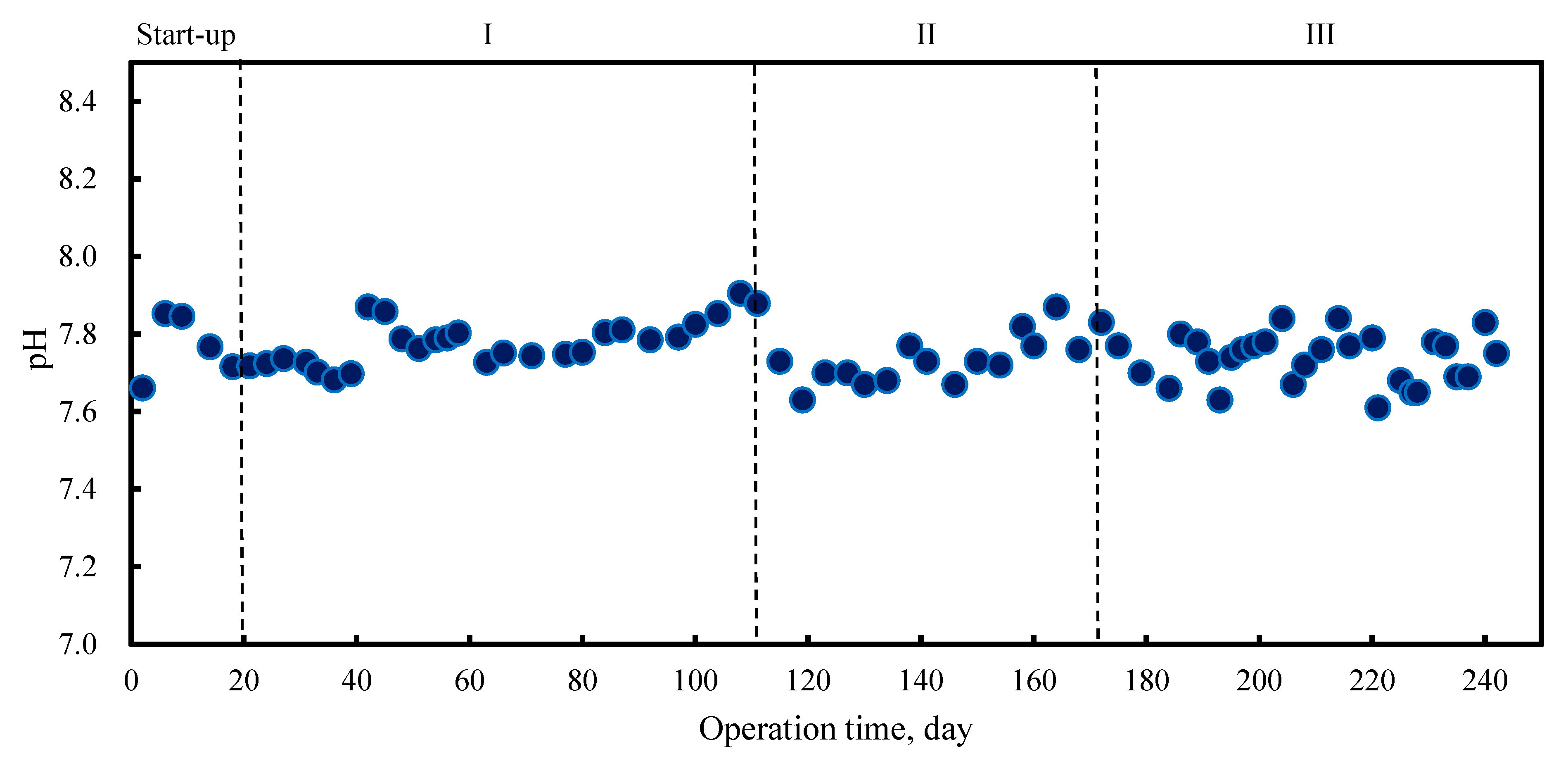
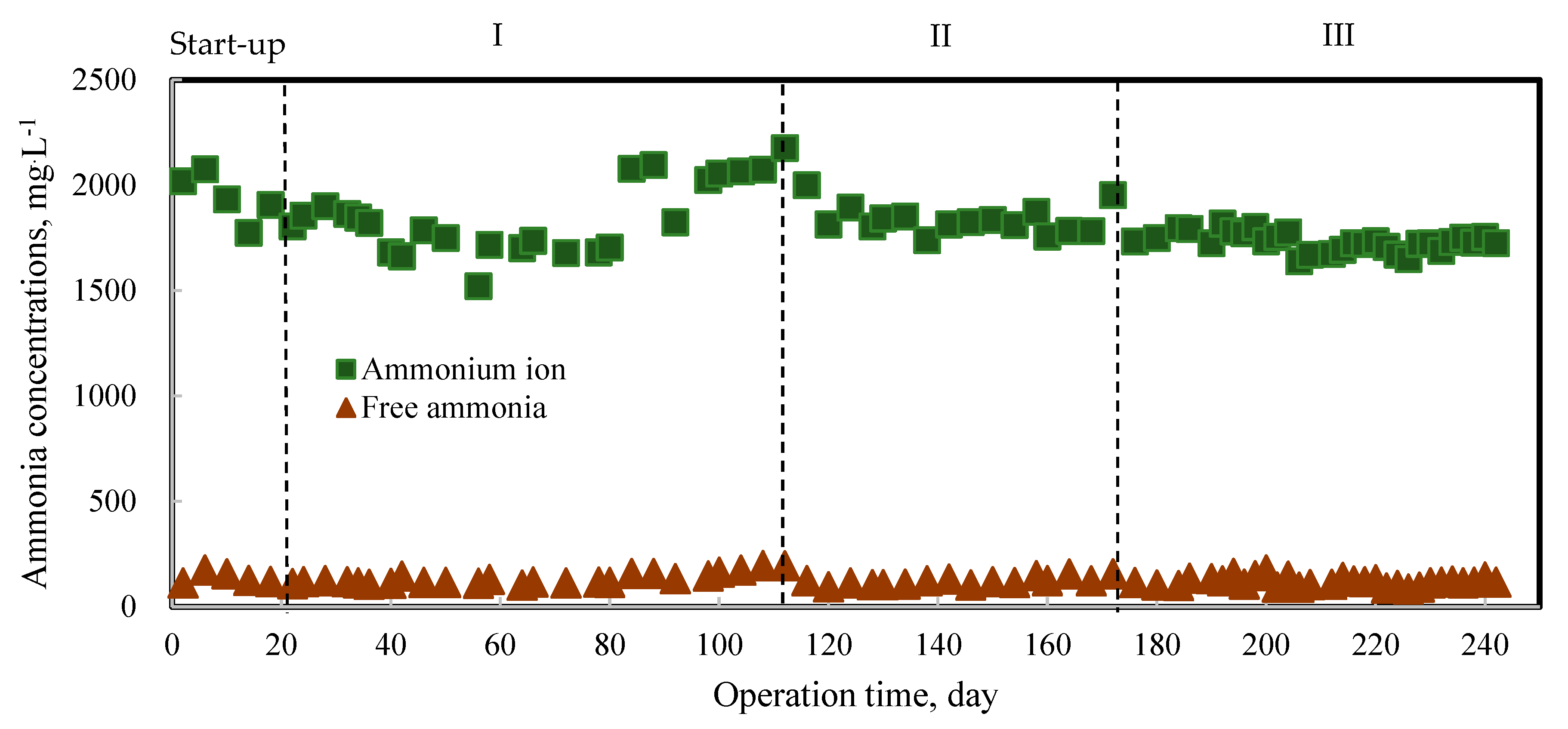
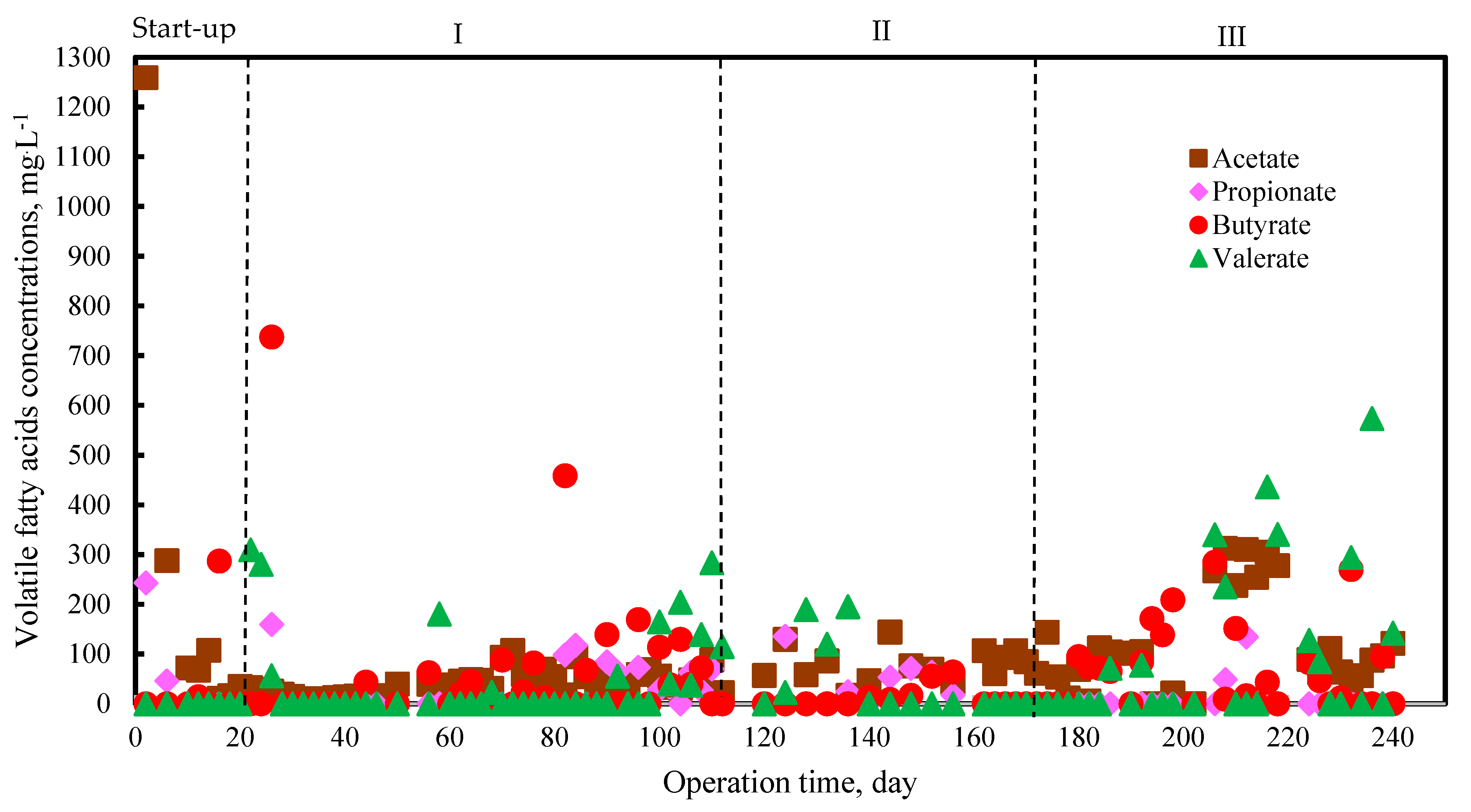
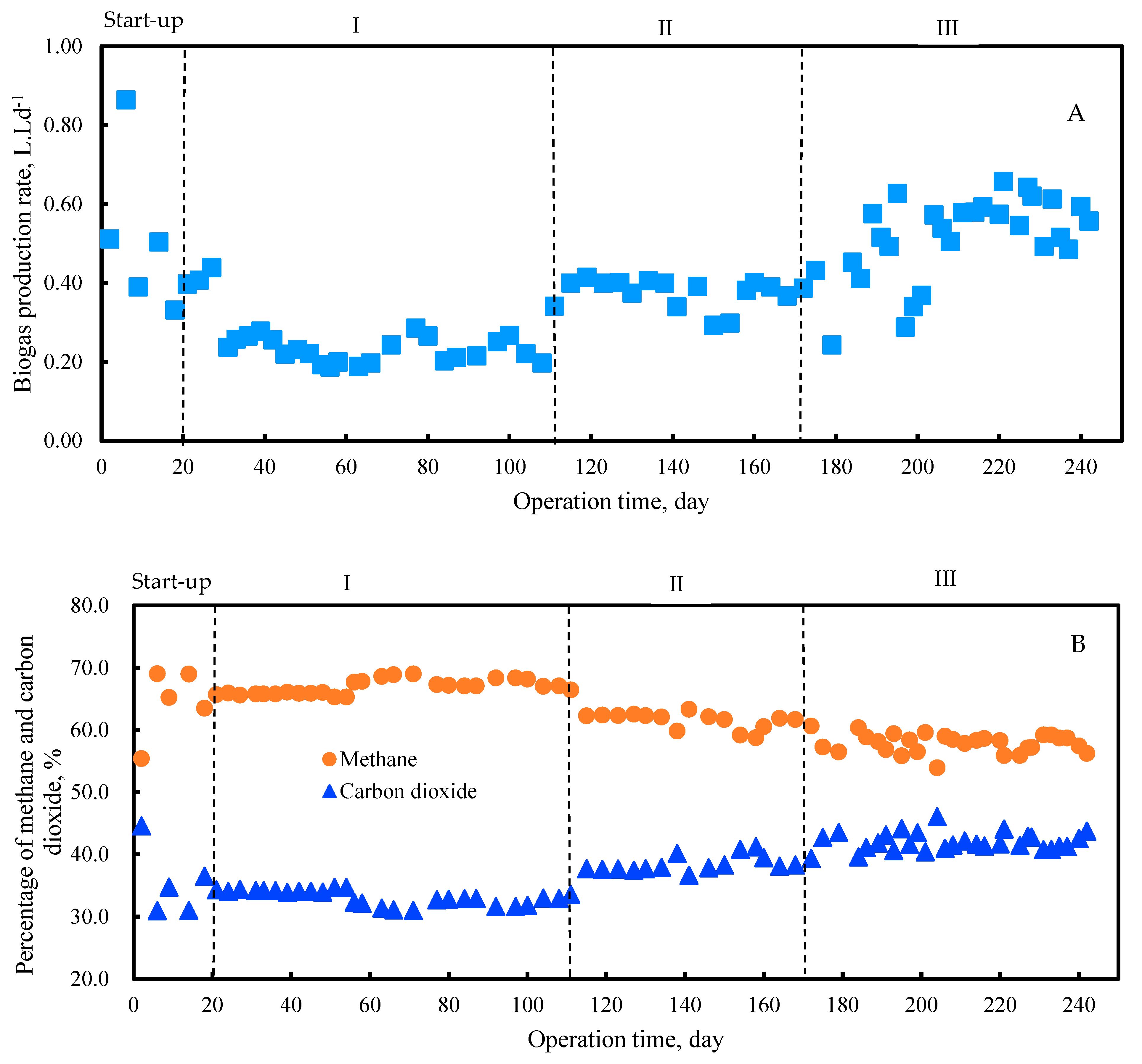

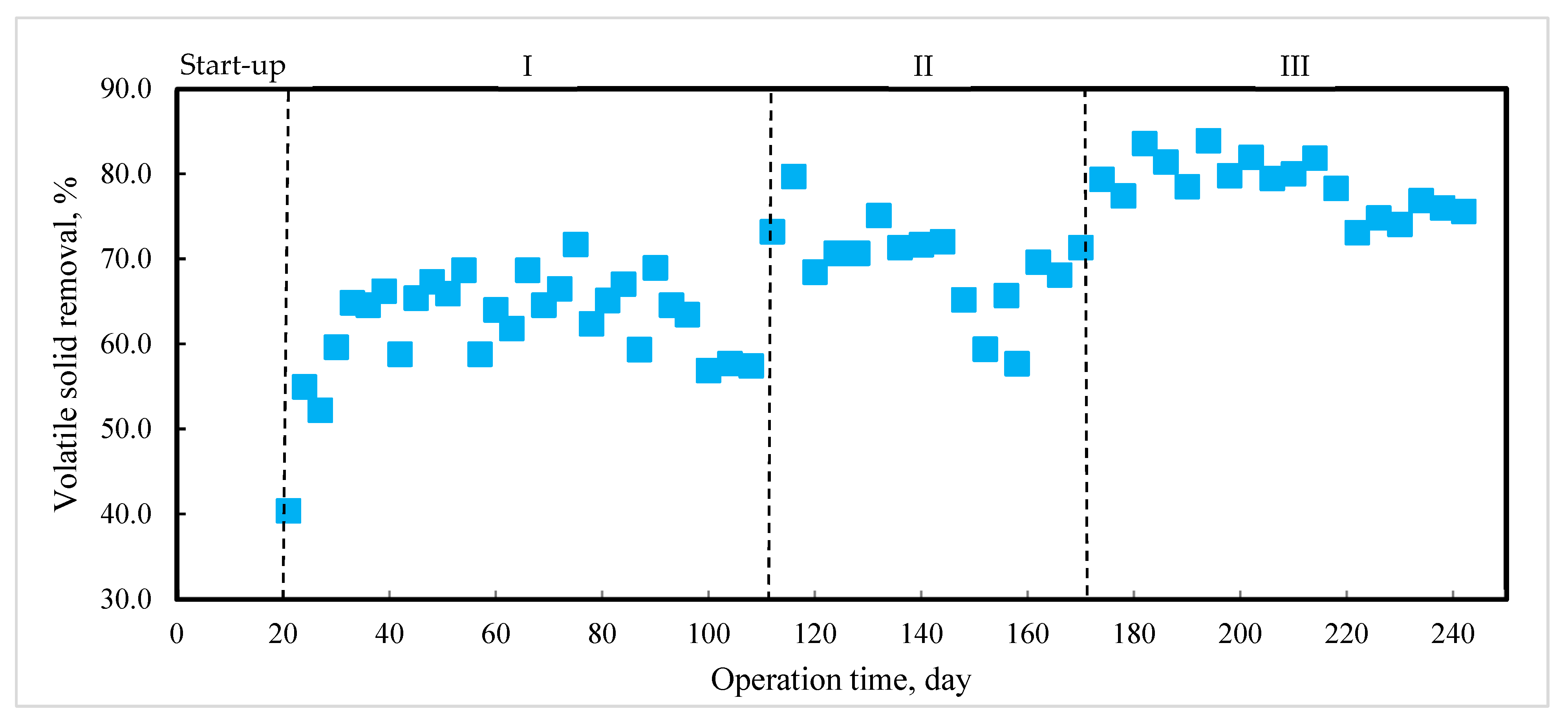
| Parameters | Unit | PM | FLF | Inoculum |
|---|---|---|---|---|
| pH | - | 6.3 | 3.5 | 7.8 |
| Total solid | % | 4.17 | 14.38 | 1.77 |
| Volatile solid | % | 1.54 | 13.71 | 1.17 |
| TN | (mg·L−1) | 3665 | 2230 | 3807 |
| TC | (mg·L−1) | 15,600 | 38,592 | 3705 |
| DOC | (mg·L−1) | 15,570 | 38,563 | 2240 |
| C/N ratio | - | 5.2 | 19.7 | 6.6 |
| NH3 | (mg·L−1) | 3.6 | 0 | 94.8 |
| NH4+ | (mg·L−1) | 2260 | 130 | 1955 |
| Acetate | (mg·L−1) | 4078 | 2472 | 220.86 |
| Propionate | (mg·L−1) | 1880 | 386 | 0 |
| Butyrate | (mg·L−1) | 0 | 69.6 | 0 |
| Valerate | (mg·L−1) | 0 | 66.2 | 0 |
| Parameters | Start-Up | Phase I | Phase II | Phase III |
|---|---|---|---|---|
| Operation period (days) | 1–20 | 21–111 | 112–172 | 173–242 |
| Organic loading rate (gVS·Ld−1) | 0.87–1.17 | 1.17 | 1.37 | 1.58 |
| Mixture ratio of PM to FLF (% v/v) | 100:0 | 100:0 | 95:5 | 90:10 |
| Mixture ratio of PM to FLF (VS basis) | 100:0 | 100:0 | 74:26 | 59:41 |
| Study | Kaparaju et al. (2005) [19] | Panichnumsin et al. (2010) [36] | Molinuevo-Salces et al. (2012) [18] | Dennehy et al. (2018) [17] | Present Study | |
|---|---|---|---|---|---|---|
| Substrates | Pig manure: Potato industrial by-product | Pig manure: Cassava pulp | Pig manure: Vegetable processing wastes | Pig manure: Food waste | Pig manure: Fermented liquid feed | |
| Feedstock mixing ratio | 80:20 | 50:50 (VS basis) | 50:50 (dw basis) | 60:40 (VS basis) | 74:26 (VS basis) 95:5 (% v/v) | 59:41 (VS basis) 90:10 (% v/v) |
| OLR (gVS·Ld−1) | 2 | 3.5 | 0.59 | 1.5 | 1.16 | 1.58 |
| HRT (d) | 25–26 | 15 | 25 | 29 | 30 | 30 |
| SMY (mLCH4·gVS−1 added) | 330 | 290 | 285 | 333 | 280.4 | 332 |
| GPR (L·Ld−1) | NR | 1.67 | 0.25 | NR | 0.35 | 0.56 |
| CH4 (%) | 62 | 59 | 55 | NR | 60 | 57 |
Publisher’s Note: MDPI stays neutral with regard to jurisdictional claims in published maps and institutional affiliations. |
© 2022 by the authors. Licensee MDPI, Basel, Switzerland. This article is an open access article distributed under the terms and conditions of the Creative Commons Attribution (CC BY) license (https://creativecommons.org/licenses/by/4.0/).
Share and Cite
Hanum, F.; Atsuta, Y.; Daimon, H. Methane Production Characteristics of an Anaerobic Co-Digestion of Pig Manure and Fermented Liquid Feed. Molecules 2022, 27, 6509. https://doi.org/10.3390/molecules27196509
Hanum F, Atsuta Y, Daimon H. Methane Production Characteristics of an Anaerobic Co-Digestion of Pig Manure and Fermented Liquid Feed. Molecules. 2022; 27(19):6509. https://doi.org/10.3390/molecules27196509
Chicago/Turabian StyleHanum, Farida, Yoichi Atsuta, and Hiroyuki Daimon. 2022. "Methane Production Characteristics of an Anaerobic Co-Digestion of Pig Manure and Fermented Liquid Feed" Molecules 27, no. 19: 6509. https://doi.org/10.3390/molecules27196509
APA StyleHanum, F., Atsuta, Y., & Daimon, H. (2022). Methane Production Characteristics of an Anaerobic Co-Digestion of Pig Manure and Fermented Liquid Feed. Molecules, 27(19), 6509. https://doi.org/10.3390/molecules27196509






